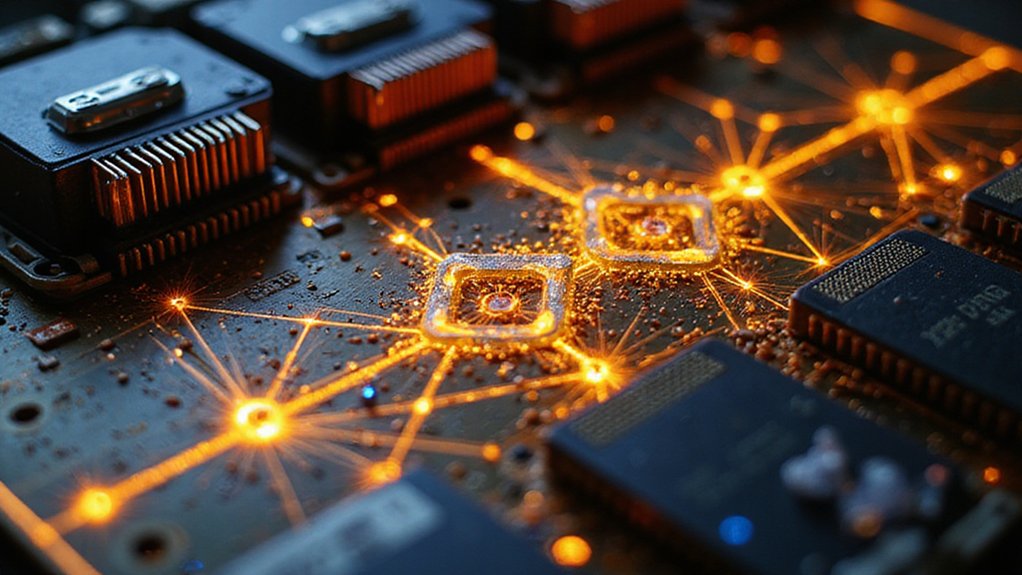Proof of Work (PoW) is a decentralized consensus mechanism that transforms simple database updates into energy-intensive computational competitions. Miners use specialized hardware to solve cryptographic puzzles—essentially guessing hash values through billions of attempts—with winners receiving newly minted cryptocurrency and transaction fees. This lottery-like system creates an economic barrier protecting transaction history, since altering past blocks requires reproducing cumulative computational work. The mechanism’s security comes at considerable environmental cost, though exploring its intricate mechanics reveals fascinating economic incentives.

While the concept of requiring computational effort to validate digital transactions might seem like an elaborate solution to a problem that traditional banking solved decades ago, Proof of Work (PoW) represents one of cryptocurrency‘s most ingenious—and arguably the most wasteful—innovations. This decentralized consensus mechanism transforms what could be a simple database update into an energy-intensive computational marathon, where participants called miners compete to solve cryptographic puzzles that serve no purpose beyond proving they’ve expended considerable resources.
PoW transforms simple database updates into energy-intensive computational marathons where miners compete to solve purposeless cryptographic puzzles.
The mining process operates on a principle that would make Sisyphus proud: miners deploy specialized hardware (ASICs or GPUs) to repeatedly guess hash values using the SHA-256 cryptographic function until one discovers a solution below the network’s predetermined threshold. The victorious miner—having essentially won a lottery requiring billions of computational attempts—receives newly minted cryptocurrency and transaction fees as compensation for their Herculean digital effort.
What makes this system particularly fascinating is its self-regulating nature through difficulty adjustment algorithms. Every 2016 blocks (approximately two weeks), the network recalibrates the puzzle complexity to maintain Bitcoin‘s sacred ten-minute block time, regardless of whether mining power increases or decreases. This guarantees that even if every computer on Earth suddenly began mining, blocks would still emerge at predictable intervals—a feat of algorithmic homeostasis that would impress any economist.
The security benefits, however, justify this computational extravagance. PoW creates an economic fortress around transaction history: altering past blocks requires reproducing the cumulative computational work of all subsequent blocks, making double-spending attacks prohibitively expensive. Multiple nodes verify each proposed block, creating redundant validation layers that eliminate single points of failure inherent in centralized systems. The network’s robust security stems from its decentralized architecture, where the computational demands make it impractical for any individual entity to compromise the blockchain’s integrity. Unlike DeFi protocols that use smart contracts for automated financial services, PoW focuses specifically on securing the underlying blockchain through computational proof.
Yet the economic incentives reveal PoW’s elegant brutality. Miners must continuously balance operational costs against volatile rewards, creating a natural selection pressure that drives hardware innovation while consuming enough electricity to power small nations. The concept originally evolved from digital tokens when Hal Finney adapted it in 2004 using SHA-1 hashing before Bitcoin’s later implementation.
This resource intensity transforms network security into a measurable commodity—literally purchasing immutability through energy expenditure—while simultaneously generating environmental concerns that make traditional banking’s carbon footprint appear quaint by comparison.
Frequently Asked Questions
How Much Electricity Does Proof of Work Mining Actually Consume?
Proof of work mining consumes staggering amounts of electricity—Bitcoin alone devours approximately 162 terawatt-hours annually, rivaling Poland’s entire national consumption.
Each Bitcoin transaction requires roughly 703,250 watt-hours (compared to Visa’s modest 1.5 watt-hours), while US mining operations account for 0.6-2.3% of total electricity demand.
This energy intensity stems from miners’ relentless computational race to solve cryptographic puzzles, creating an environmental predicament that makes traditional banking seem positively green.
Can Proof of Work Be Made More Environmentally Friendly?
Proof of work can indeed become more environmentally palatable through several approaches.
Mining operations increasingly migrate toward renewable energy sources (hydro, solar, wind), while next-generation ASIC hardware delivers superior hash rates per watt consumed.
Advanced cooling technologies like immersion systems reduce auxiliary power demands, and waste heat recovery repurposes thermal byproducts.
However, the most dramatic environmental improvements require shifting to alternative consensus mechanisms like proof of stake.
What Happens When All Bitcoins Are Mined Using Proof of Work?
When Bitcoin’s 21 million coin limit is reached around 2140, miners will abandon block rewards entirely, surviving solely on transaction fees.
This change fundamentally shifts Bitcoin’s economic model—miners must validate transactions without new coin incentives, relying on fee revenue alone.
The network’s security depends on sufficient transaction volume generating adequate fees to maintain miner participation, creating an intriguing test of whether pure fee markets can sustain decentralized cryptocurrency operations.
Which Cryptocurrencies Besides Bitcoin Use Proof of Work Consensus?
Several major cryptocurrencies maintain proof-of-work consensus beyond Bitcoin.
Ethereum Classic stubbornly continues PoW after Ethereum’s merge, while Litecoin employs Scrypt algorithms for purported ASIC resistance.
Bitcoin Cash preserves Bitcoin’s mechanics with larger blocks, and Dogecoin—remarkably evolved from internet jest to legitimate payment rail—utilizes compatible Scrypt mining.
Monero pursues privacy-focused PoW with frequent algorithm updates preventing ASIC dominance, though one wonders if such constant tinkering truly enhances decentralization.
How Long Does It Take to Solve a Proof of Work Puzzle?
Proof of work puzzle solving times vary dramatically by design and hardware.
Bitcoin targets roughly 10 minutes per block through difficulty adjustments, while Litecoin aims for 2.5 minutes using its Scrypt algorithm.
However, actual solving time depends entirely on computational power deployed—early CPU miners took considerably longer than today’s specialized ASICs, which can solve puzzles in seconds (though network difficulty automatically compensates to maintain target intervals).









